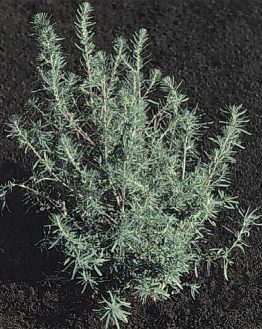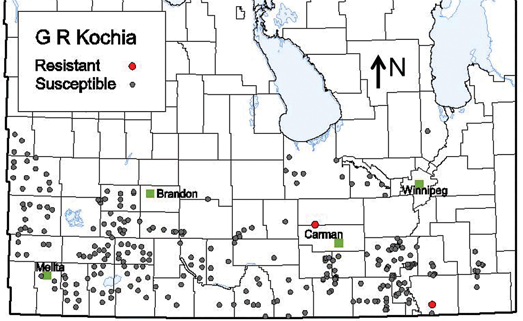Glyphosate-resistant kochia survey
Key practice: Taking action to manage glyphosate-resistant kochia before it is visible in the field is critical to success. Use a rotation of broadleaf control products with good activity on kochia.
Project title, Lead researcher: “Glyphosate-resistant kochia (Kochia scoparia L. Schrad.) in Saskatchewan and Manitoba,” 2013-14,
Hugh Beckie, Agriculture and Agri-Food Canada (AAFC)
Grower organization funder: ACPC, SaskCanola
As the most-widely used herbicide in Western Canada and around the world, glyphosate popularity has led to global selection for glyphosate-resistant (GR) weeds. Kochia was the first GR weed in Western Canada, confirmed present in southern Alberta in 2011. The efficacy of herbicides is much stronger on weeds when they are small, and taking measures against GR kochia before it is visible in the field is critical to successful management.

Hugh Beckie, who accurately predicted that kochia was becoming glyphosate resistant, continues to study options for its control. Building on kochia surveys conducted in Alberta in 2011 and 2012, 615 sites across southern Manitoba and southern and central Saskatchewan were surveyed in the fall of 2013.
The collection and screening of mature plants confirmed 17 GR kochia populations in Saskatchewan and two in different parts of the Red River Valley in Manitoba. The majority of these originated in chemfallow fields, but some were derived from fields of GR canola, B. napus L, GR corn and soybean as well as non-cropped areas.
In an earlier study, Beckie found that 90 percent of Prairie kochia populations were resistant to acetolactate synthase (ALS) inhibitor Group-2 herbicides. In 2011, he discovered kochia in southern Alberta with multiple resistances to glyphosate and ALS-inhibitors. A 2012 survey in that region identified GR kochia in four percent of fields surveyed. In addition, 10 of the kochia samples submitted from growers in west-central and southwest Saskatchewan were also confirmed as GR. The most recent studies conducted in south-central Saskatchewan and southern Manitoba support these findings.
These post-harvest surveys were conducted to determine GR kochia’s geographical distribution and abundance. Sites were randomly predetermined
and viable seeds were collected from: 342 sites in the mixed grasslands and moist mixed grasslands (Brown/Dark Brown Soil Zones) of Saskatchewan;
and 283 sites in the Aspen Parkland and Lake Manitoba Plain eco-regions
of southern Manitoba.
Among the confirmed samples from Saskatchewan, six were from municipal-ities where GR kochia populations had not previously been found. Added to the previously confirmed populations, GR kochia has now been identified in a total of 14 municipalities across the province.
The two confirmed GR samples from Manitoba derived from a GR corn crop in the south-central portion of the Red River Valley and a GR soybean crop in the southeast. This lower occurrence was as expected due to the much lower frequency of chemfallow in Manitoba and the strong link between this practice and glyphosate resistance.
All GR kochia populations from Saskatchewan and Manitoba proved susceptible to dicamba, an organo-chloride compound with reported resistance in the U.S. The effectiveness of alternative herbicides was also confirmed in greenhouse studies.
Conclusions
Agronomy recommendations based on this study are:
- The cost-benefit of chemfallow needs to be closely evaluated due to its strong association with GR kochia.
- Better cover crops where chem-fallow is practiced would lessen selection pressure.
- Reliance on the same tank-mix partner will inevitably select for multiple-resistant weed populations.
Beckie also warns of the future risk for glyphosate resistance in other abundant weed species including wild oats, green foxtail, cleavers and wild buckwheat.
Periodic surveys of GR kochia will continue across the Prairies as the demonstrated ease of spread demands close monitoring and a collective response to management.






